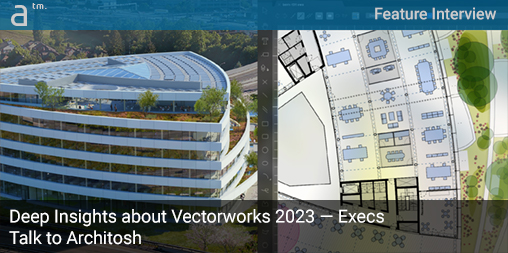“DESIGNERS EVERYWHERE ARE SEARCHING FOR TIME,” says the main promotional video on Vectorworks Inc.’s website—showcasing some of the best new features in the globally popular BIM and design CAD software. One might assume that the statement is just a savvy marketing phrase. However, they would be very wrong.
Time is the New Money
Ever since the global pandemic, a set of converging forces has reared its head in the AEC world—especially in Architecture. Time has a new value. When billions of people worldwide were forced to stay at home, away from offices, schools, and institutions due to COVID-19, people everywhere were suddenly gifted some additional time. And with that gift came a new sense of its actual value.

Vectorworks 2023 advances multi-core processing, this time targeting section viewports and pairing them with caching improvements. It means users gain snappier section viewports while maintaining the flow in their processes. (click for larger view)
Given its new perceptual value, architects especially are searching for more time. This search has manifested in unionization movements on both sides of the Atlantic, revolts in architecture schools, and even public protests against digital tool makers. The issue at hand is this: after two whole decades since the digitization of architecture, engineering, and related industry design fields, productivity rates in AEC still lag compared to every other sector of the economy.
Acceleration and Value
However, things are about ready to change. Emerging technologies promising step-change or full-factor workflow speed-ups are blossoming into industry-wide adoption. And digital tool makers in AEC, like Vectorworks, Inc., are on the leading edge of some of these new developments.
One such development is in the chip industry, where powerful ARM-based chips in mobile devices enable dramatic new capabilities like reality capture. Apple’s use of these chips in larger sizes in their Mac computers has pushed them to the industry forefront. And Vectorworks beat all of its leading global competitors in getting the first BIM platform into the market for Apple’s powerful M-chip (ARM technology) computers.
The biggest thing is the component wrapping…not many other BIM products give you the same functionality of component wrapping as Vectorworks Architect 2023 does.
Dr. Biplab Sarkar, Vectorworks’ CEO, was the company’s long-time CTO and continues to lead the company’s development to leverage key computer industry trends and strategic partnerships. Vectorworks has benefitted because it adopted the world’s most popular and technically proficient geometry modeling kernel in Siemens’ Parasolid technology. With the resources of the German giant, Vectorworks’ critical 3D modeling technology advances to support new platforms—whether Apple’s iOS platform in the last decade or ARM chips in computers in this decade emerging—without the company having to dedicate extensive internal resources.
Those resources can be spent more wisely on direct user features in 3D modelings, like the new Offset Edge tool in Vectorworks 2023. In quickly reviewing the new feature, users will have dramatically faster ways to model complex 3D forms that are commonplace in design—like rounded steps in a garden park, complete with concealed LED lighting strips.
“We placed a high emphasis on delivering first-class modeling capabilities to our users,” says Dr. Sarkar, “and we continue this with the release of Vectorworks 2023. The push-pull capabilities using the new Offset Edge tool included in our latest version work on non-planar faces while creating solid primitives with history. So in this case, we exceed the offerings of many rival solutions.”
High-Speed BIM
New in Vectorworks 2023 is a new technology that rapidly lets designers and architects place fenestration elements on walls with a click-and-drag approach. You still have to define a default look (like a basic casement or fixed window), but once determined, the user creates windows and doors by dragging rectangles on wall surfaces. There is also a new rapid way to draw them in 2D models with a simple line.

The Wall Tool is now “feature complete” as part of its new architecture and is possibly the most advanced in the industry with its component wrapping and termination possibilities.
“The new feature feels like painting doors and windows on a wall,” says Steve Johnson, chief technology officer of Vectorworks, Inc. “It makes the interface much quicker. Once you place a window, you can grab the grips and reshape it like any other element in Vectorworks. And it respects Styles, so if there are constraints in height, for example, it respects that.”
Architects bleed out time daily, fussing in complex parametric object dialog boxes—this new feature in Vectorworks 2023 addresses this head-on. And the technology behind this change is headed to other parts of the program in the future. “We can see this growing, and we have cabinets working this way in the future,” says Johnson.
Another high-speed BIM feature in Vectorworks 2023 is the new improvements to the Wall Tool. New insertion location options into the wall layers enable targeted per-wall-element wrap to insertion location settings, generating more flexibility in how walls function and graphically represent in 3D view models.
“The same wall tool now allows the user to place straight or curved walls into their designs,” says Johnson. “The biggest thing is the component wrapping…not many other BIM products give you the same functionality of component wrapping as Vectorworks Architect 2023 does.”
next page: Maturing BIM, Talking Markets and Strategy…







Reader Comments
Comments for this story are closed